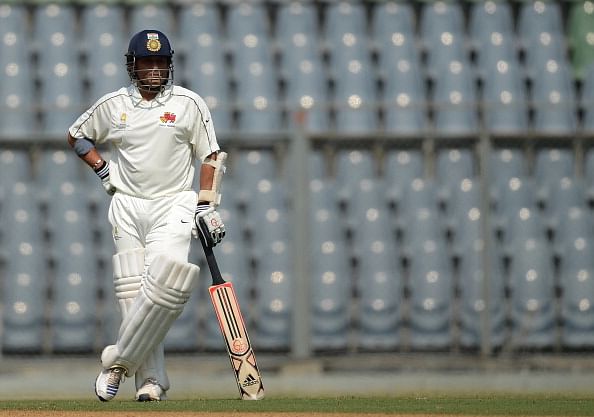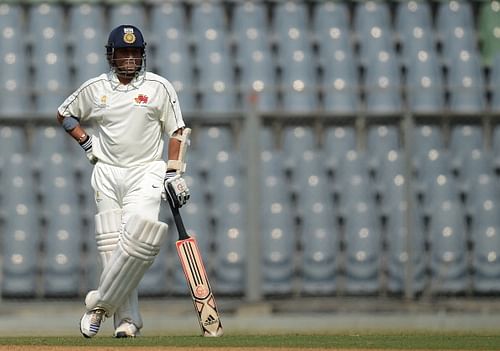
Domestic cricket - how much does it matter?

Empty stands are a common sight in domestic cricket, even when superstars are playing
With the constant noise of traffic, and people walking through a mixture of powdery dirt and stones on roads without footpaths, a busy junction on Uppal-Ramanthapur road looks appropriate for a dusty, colourful city. But it camouflages the feel of a lonely, narrow stretch of road that leads the fan to the newly built stadium. That is, when there isn’t any high-profile cricket game on.
When Australia played here early last year, the same road looked insufficient to ensure an easy walk for the eager crowd towards the entrance. Security guards checked you thoroughly, and disallowed cell phones into the stands – the seriousness catalysed by a recent bomb blast in town. Once you took in the sight of fielders surrounding the pitch, in the middle of the outfield that looks extraordinarily green, the discomfort eased away. You settled in a convenient seat amid a group of people holding a similar sense of anticipation.
This occasion was perhaps too big to be compared to a Ranji Trophy final, but the difference in the atmosphere was noteworthy nonetheless when Hyderabad hosted Karnataka and Maharashtra, the two finalists, last week. Visitors interested in consuming the game live were allowed free of cost, and the numbers were expectedly few enough to be accommodated in one section of a stand.
The crowd, if it can be classified as one, was a blend of youngsters and middle-aged men, some looking on more keenly than others, who seemed to arrive at the stadium to catch the sight of some of the well-known players.
And if those players walked towards the crowd to take their fielding position at fine-leg or long-off, (for a right-hander, depending on which end the bowling is towards) a distraction from the periods of lull would have been found. They would shout a name to catch the attention of the player, who would ignore the calls for most of the time to concentrate on the game.
Sometimes, after persistent calls, he would look at the crowd for a second and raise his hand loosely, to a shout of cheer. Some would walk up towards the barrier, request the ball boy to hand over a piece of paper and a pen to the fielder, to obtain an autograph.
It was far more difficult to manage such acknowledgement from fielders positioned further away into the field.
When the batsmen in the middle defended every ball, as in the partnership between Karun Nair and Amit Verma on the third day, efforts were made with humorous and cheap one-liners to distract people from stupor. Comments of ‘nicely played’ to a defended innocuous delivery were laughed at. An appeal from the bowler acted as a medicine, for the crowd became more involved. A boundary scored or a wicket taken revealed flags of yellow and orange waved by enthusiasts.
Overall, the mood was like a group of people in a single-screen theatre watching a boring film. People walked in and walked out at will, not knowing how to kill their time. Not that anyone cared.
Following domestic tournaments live is different in that it filters the noise from substance, and helps you savour a game more peacefully. But overdoing passivity also takes away the experience.
The final was an intensely fought contest; both teams grappled with phases of slide with periods of resistance. Maharashtra struggled a little more than Karnataka, for their first innings wasn’t fruitful enough, but they kept themselves more than afloat in the contest till the final day, when their opponents made light work of the chase of 157, and took their second Ranji Trophy victory.
Much has been written in the media about this triumph; the players of Karnataka even likened this to the feeling of winning a World Cup. They would be used to playing in front of empty stadiums, and would be convinced in an era of professionalism to be able to produce their best in all circumstances.
But what was missing here, even they would recognise, was some good involvement by the public at large at such an important game. It may have made their victory a little sweeter, since the participation of a larger group of people in it would have killed any lingering sense of pointlessness.
A week later, though, the ambience was a little enhanced. During a hot day in Bangalore, and on a track full of grass, Dinesh Karthik smartly ground out a firm yet stylish 91 for the Rest of India in the ongoing Irani Trophy. But just when a member of the audience would want to start a chorus of ‘Karthik, Karthik’, he would be drowned by chants of the bowler’s name, regardless of how well or bad he had been bowling. For even more encouragement, a crescendo of claps would greet the bowler as he would be about to deliver the ball.
As expected on a stubbly first-day pitch, wickets fell amid relatively small intervals of resistance. As the crowd poured into a section of the second tier, having been given the size of about a quarter of the capacity of the Stadium to situate itself for a satisfying view below, the cheering felt increasingly in favour of the home side – the bowling team. An appeal would be echoed tenfold, and a dismissal would be greeted with a loud cheer. And if Karthik cover-drove or hooked with panache, which he did when he had got the better of all the Karnatakan bowling on the either side of tea, the stroke would be admired with silent nods and subdued claps.
Until a ball, struck hard and flying past mid-on, is plucked from the air by a diving Robin Uthappa. People would then rise up in unison to clap and give celebratory hoots. As the batsman walked towards the pavilion, the acknowledgement of his efforts would become less apparent from the crowd than the pleasure in seeing him go.
The batting wouldn’t last long thereon, ending in a few minutes with the leg stump of No. 11 Pankaj Singh flying out of its groove, an hour before close of play. It capped off a shaky innings by an assembled team, held together only by three partnerships, all featuring Karthik. No. 7 Amit Mishra was the other main contributor, scoring a lively 47.
But all the potential of a decent looking top order was largely blunted by the captain of the home side, Vinay Kumar, who ended with six wickets. His early exploits nipped the batting in the bud, and since then Rest of India could only work to mitigate the disadvantage.
All this was taken in rather keenly by spectators. Winning the Ranji Trophy seemed to have propelled the locals to be a part of this fixture. So, that final in Hyderabad may not have been so pointless after all.
Although the interest in the domestic game is less, it is on its way up, since it is being shown live on television as well for a few years now. That has an effect – it has perhaps crossed the phase where it didn’t matter at all to the ones who cared about catching some excitement in the stadium. Yet, a lot needs to be done.